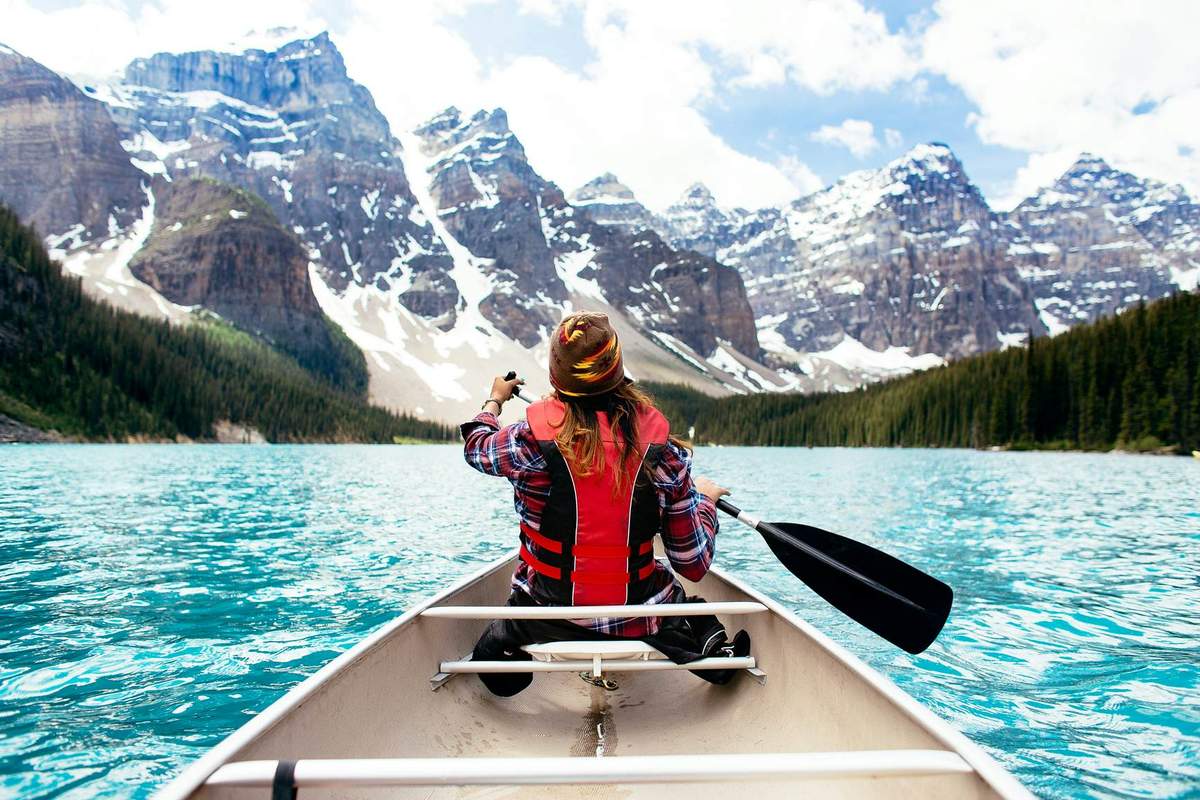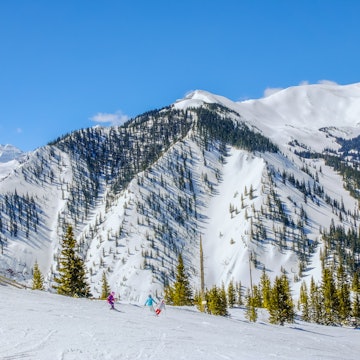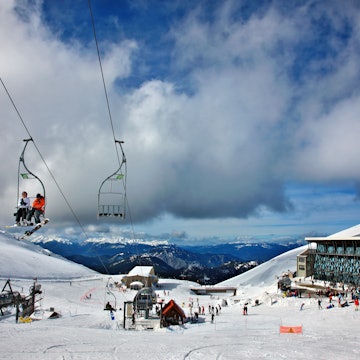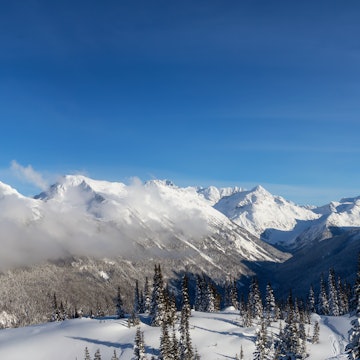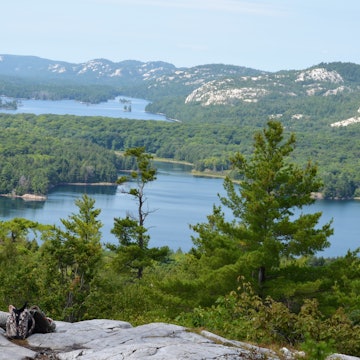
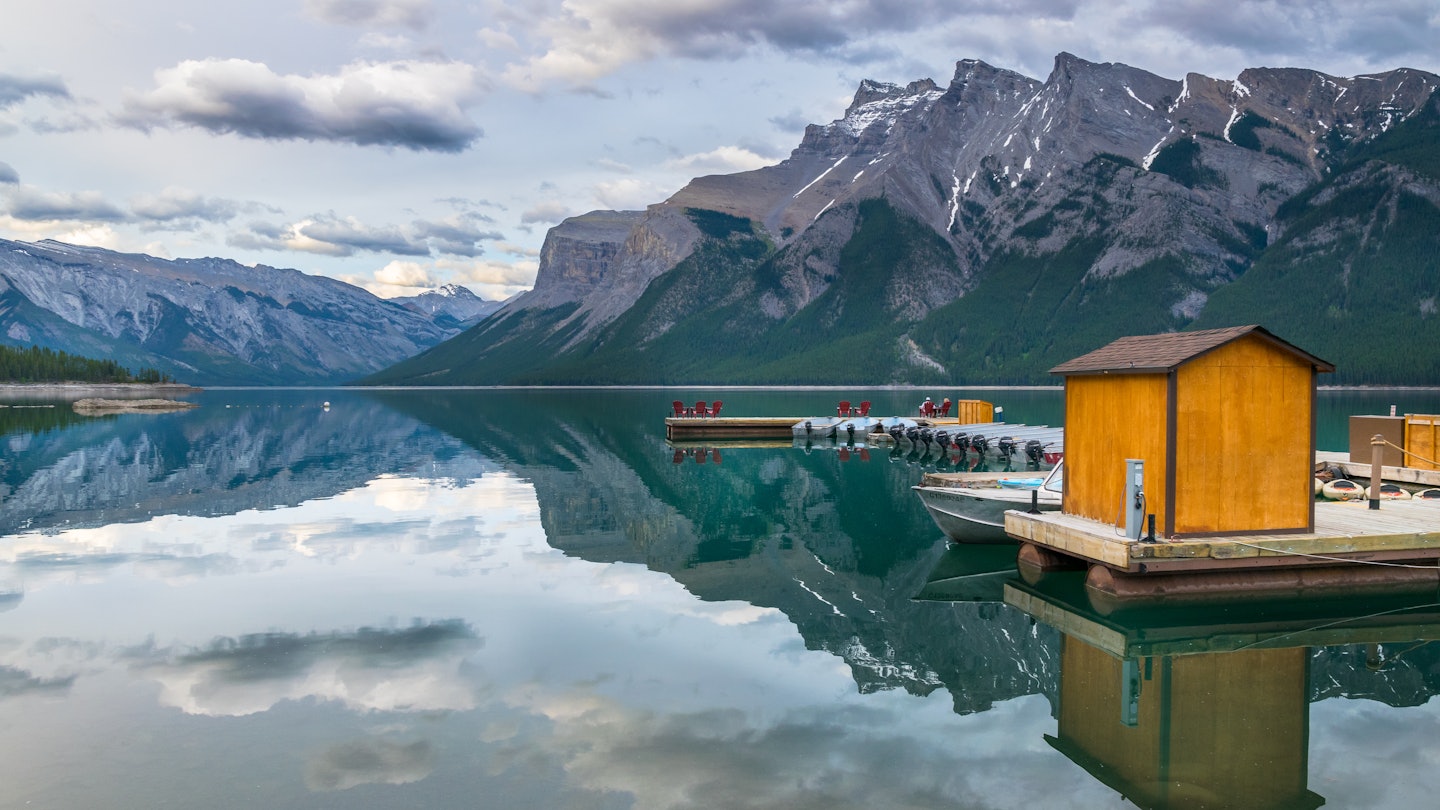
Lake Minnewanka, Banff National Park. Nido Huebl/Shutterstock
A piece of Canadian history, Banff National Park is the world’s third-oldest national park and, over the course of its 140-year existence, has managed to walk a fine line between easy access and careful environmental protection.
Banff contains some of the nation’s most emblematic landscapes, including Lake Louise. Straddling the Rocky Mountains just west of Calgary, it draws in more than four million visitors each year without sacrificing its delicate ecological integrity. Aside from a townsite, the park has three ski resorts, three national historic sites, a well mapped trail network and numerous kayak-able lakes and waterways. Despite its popularity, its immense backcountry remains only lightly trodden.
Make the most of your first visit to Banff National Park with our top tips on things to do, where to stay and how much to budget.
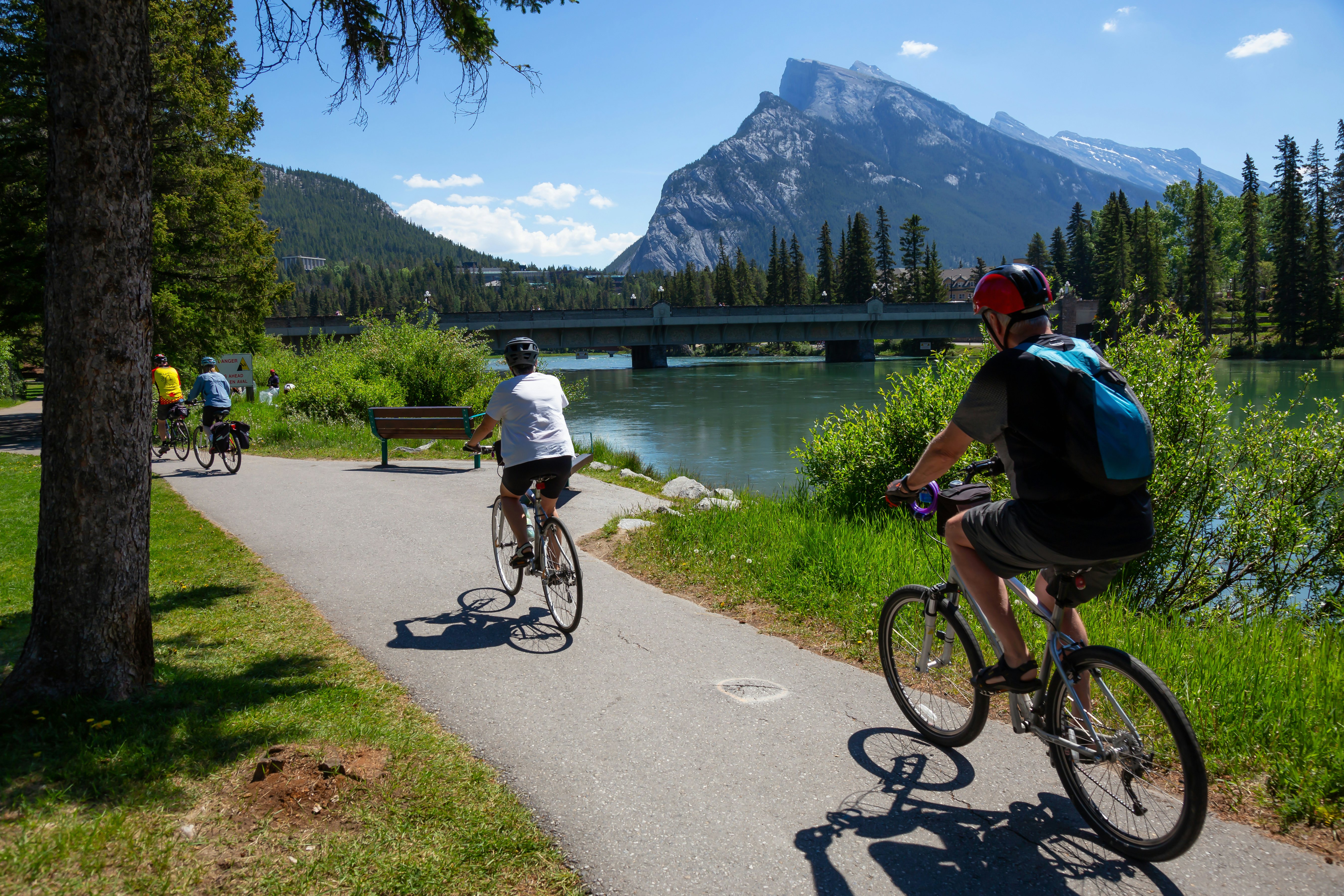
When should I go to Banff National Park?
Unlike many Canadian national parks that offer lean pickings in the winter, Banff is a year-round destination, courtesy of its three ski resorts and raft of winter activities, which keep it buzzing even in the coldest months.
Notwithstanding, summer is, arguably, the best time to visit with most facilities open between Victoria Day (the penultimate Monday in May) and Labor Day (the first Monday in September). Bear in mind that trails and campgrounds at higher altitudes can remain snowbound until late June or early July depending on the weather.
The first boat cruises usually head out on Lake Minnewanka in mid-May and run until mid-October. Lake Louise and Moraine Lake typically thaw a couple of weeks later. Wildflowers blossom in subalpine areas such as Sunshine Meadows from late June to early September, with the last two weeks in July being the most vibrant. This is also the peak season for mosquitoes and forest fires.
Prices slip down a notch after Labor Day and good hiking is usually viable until early October when the larch trees are at their finest. The ski resorts normally open in early November and run until late April or May (Banff Sunshine stays open until late May).
How much time should I spend in Banff National Park?
Banff National Park gets a lot of drive-through traffic, and a sizable number of visitors never make it much further than the shops and sights of Banff Avenue, the central street in Banff Town.
To get a wider view of the park beyond the townsite you need at least three days. To really start to get under the skin of the place, reserve a week. If you’re camping or undertaking some long-distance hikes, you could quite conceivably spend two or three weeks roaming the park’s ample backcountry.

How do I get to Banff National Park?
The nearest airport is Calgary International, 145km (90 miles) to the east. Hwy 1, aka the Trans-Canada Hwy, cuts directly through the park, east to west. It’s easy to get to Banff without a car, however, having your own wheels will give you flexibility and allow you to make spontaneous stops when you’re cruising along Hwy 1 or the Icefields Parkway. Bus-wise, the Banff Airporter runs around a dozen times daily between Banff and Calgary Airport. The Brewster Express links Calgary Airport with downtown Calgary, Canmore, Banff Town and Lake Louise.
How do I get around Banff National Park?
It's relatively simple to get around the park once you’re there. Banff has its own local public transit network called Roam, which serves the Upper Hot Springs, Canmore, Lake Louise and – seasonally – Lake Minnewanka and Johnston Canyon. Sundog runs a daily year-round bus north along the Icefields Parkway to Jasper via Lake Louise. Banff Sunshine operates a free summer and winter shuttle to the base of the Sunshine Village gondola.

Top things to do in Banff National Park
Hike amid wildflowers in Healy Meadows
While Sunshine Meadows may have Banff’s most accessible subalpine flower meadows courtesy of its summer gondola, Healy Meadows, abutting the Continental Divide on the border of Alberta and British Columbia (BC), is of equal beauty – plus you’ll see fewer people. The only caveat: you'll need to hike several kilometers through forest to get there. The reward is an unbroken carpet of flora, including purple fleabane, yellow aster, and red paintbrush, framed by broad open vistas of peaks, ridges and lakes. Healy Pass is also the gateway to the more remote backcountry around Egypt Lake.
Sip tea beside Lake Agnes
Lake Agnes Teahouse, backcountry Canada’s finest, requires a bit of grunt-work to get there – 3.5km (2.2 miles) to be precise, most of it on a gradually ascending trail that commences on the hallowed shores of Lake Louise. However, once deposited beside Lake Agnes, where the attractive wooden teahouse sits in the shadow of a grand mountain cirque, you can enjoy the most charming cuppa in Canada with sweet snacks to accompany it.

Dip an oar in Vermilion Lakes
This trio of marshy lakes close to Banff Town is a haven for wildlife, painters, photographers and oar-propelled transport. The best way to access the watery domain is to rent a canoe from Banff Canoe Club on the banks of the Bow River in town and paddle up Forty Mile Creek to the lakes themselves. With the river behind you, you’ll enter a tranquil world of foraging birds, busy beavers, lonesome moose and shimmering mountains reflected on the water.
Go mountain-biking along the Goat Creek Trail
Linking the two mountain towns of Banff and Canmore via a quiet back route that undulates for 19km (12 miles) around the western base of the Mt Rundle massif, the Goat Creek Trail is Banff’s all-encompassing off-road cycling adventure. It's wild and bumpy, but doable by families, weekend warriors and people without expert cycling skills. It starts at the Ha Ling trailhead high above Canmore and descends slowly into Banff Town, coming out near the Fairmont Banff Springs hotel. You can opt to pedal back to Canmore on the flat, paved Legacy Trail (24km; 15 miles), or take a bus. Rent bikes from Gear Up Mountain Sports in Canmore.
Ski into the Skoki Lodge
One of the oldest backcountry ski lodges in North America, the Skoki inhabits a wilderness valley of isolated lakes, peaks and meadows, 11km (7 miles) northeast of the Lake Louise ski area. A national historic site, the log-cabin-style lodge was built in 1931 and provides both accommodation and famously fortifying food. Sitting at the crossroads of several trail loops, it’s an idyllic base for cross-country and telemark skiing in winter and hiking in summer.
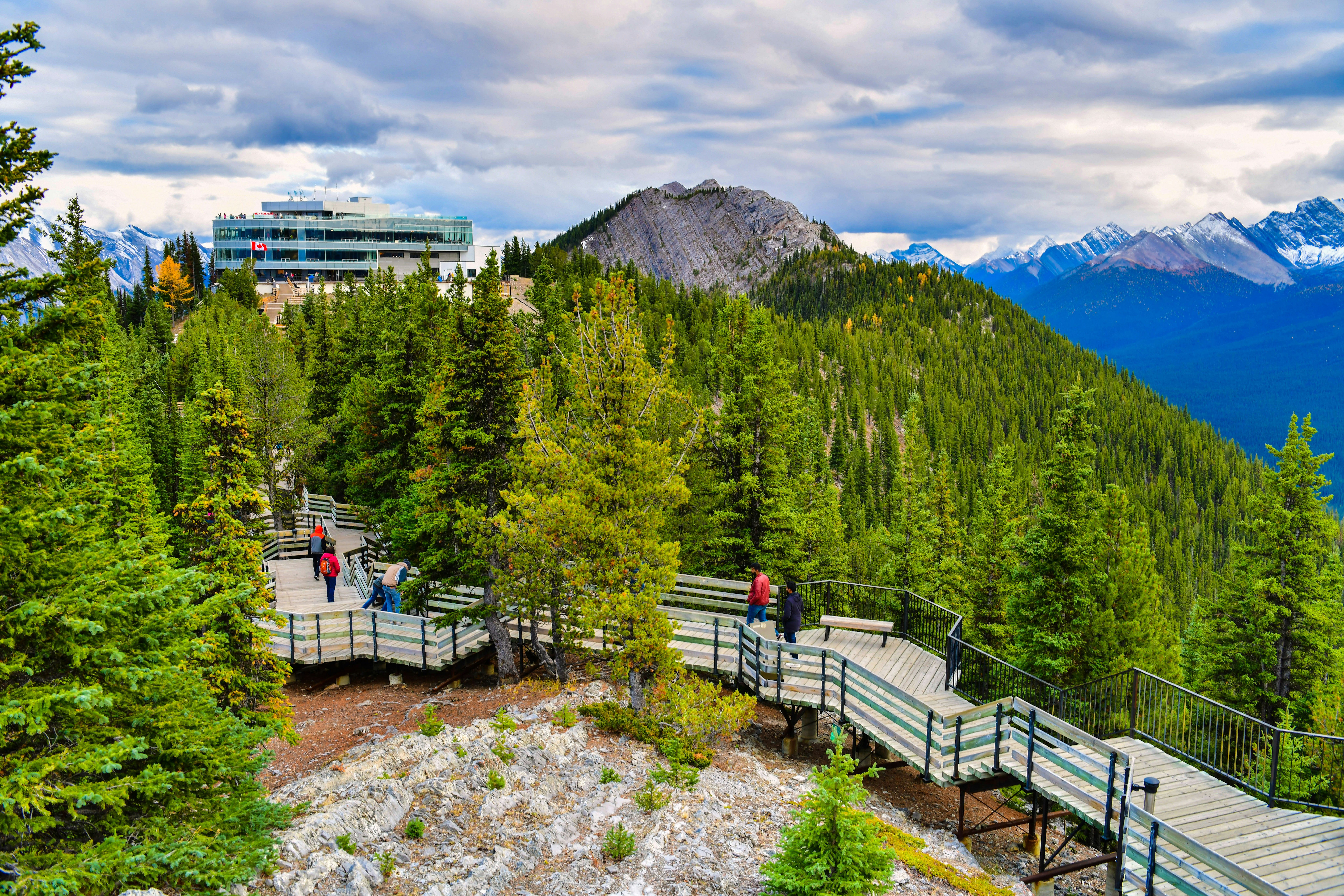
My favorite thing to do in Banff National Park: Sulphur Mountain Trail
For an action-packed Banff day out, I usually start by jogging up the zigzagging 5.4km (3.3-mile) Sulphur Mountain Trail to the top of the gondola station. After catching my breath at the summit and joining the crowds on a short interpretive walk to an old weather station, I grab a cup of coffee in the cafe and then take the gondola back down to the base. Here, I’ll lazily douse my tired muscles in the Upper Hot Springs in the shadow of Rundle Mountain. If I’m feeling flush, I’ll find time to stop off in the Fairmont Banff Springs hotel on my way back to town to enjoy a full afternoon tea experience.
How much money do I need in Banff National Park?
Compared to other parts of Canada, Banff isn’t cheap. High demand and a limited number of hotels mean high prices, especially in peak summer season. You can save money on accommodations by staying in the mountain town of Canmore, located 25km (15.5 miles) southeast of Banff, just outside the park gates. Regular public buses connect the two towns, and Canmore has more budget accommodations than Banff, including a smattering of hostels, motels and apartments. Camping is more affordable than hotel accommodations, but usually in high demand. Front-country campgrounds average $40 (US$28) per night.
Hiking is the park’s cheapest pursuit, but bike rentals aren’t extortionate either. Of Banff’s three ski resorts, Norquay is the cheapest. Save money with a Ski Big 3 lift ticket, which covers all of them.
Double room in a Banff hotel (summer): $400 (US$280)
Campground: $20–78 (US$14–55)
Backcountry camping per night: $13.50 (US$9.50)
National Park pass: $11 (US$7.72)
Bike rental per day: $50 (US$35)
Ski pass: $124–165 (US$87–116)
Dinner mains: $30–45 (US$21–32)

Are there some good day hikes?
There are tons of day hike routes to choose from. They are graded easy, moderate and difficult, and all are diligently maintained and signposted.
Great easy trails include Sunshine Meadows (10km/6.2 miles) near Banff Town, Consolation Lakes (2.9km/1.8 miles one-way) near Lake Louise, and Parker Ridge (2.7km/1.7 miles one-way) off the Icefields Parkway.
Moderate trails include Cascade Amphitheater (7.7km/4.8 miles one-way) near Banff Town, Larch Valley (4.3km/2.7 miles one-way) near Lake Louise, and Helen Lake (6km/3.7 miles one-way) off the Icefields Parkway.
Difficult trails include Cory Pass Loop (13km/8 miles) near Banff Town, Paradise Valley (10.3km/6.4 miles one-way) near Lake Louise and Sunset Pass (8.2km/5.1 miles one-way) off the Icefields Parkway.
Are there any backcountry lodges?
There are three backcountry lodges in the park, which are only accessible by foot, bike, skis or horse. All require prior reservations. They offer food as well as comfortable rustic accommodations.
The Shadow Lake Lodge dates from 1930 when the original rest house was constructed by the Canadian Pacific Railway. It can be approached from three different directions on foot, bike, snowshoes or skis, and is 14km (8.7 miles) from the nearest road.
The closest lodge to Banff Town, Sundance Lodge is 12km (7.5 miles) from the Trans-Canada Hwy and is popular with horseback riders in the summer and skiers in the winter.
The Skoki Lodge, near Lake Louise, started life as a ski lodge in the 1930s, but now also welcomes summer hikers. It’s 11km (6.8 miles) from the nearest road.
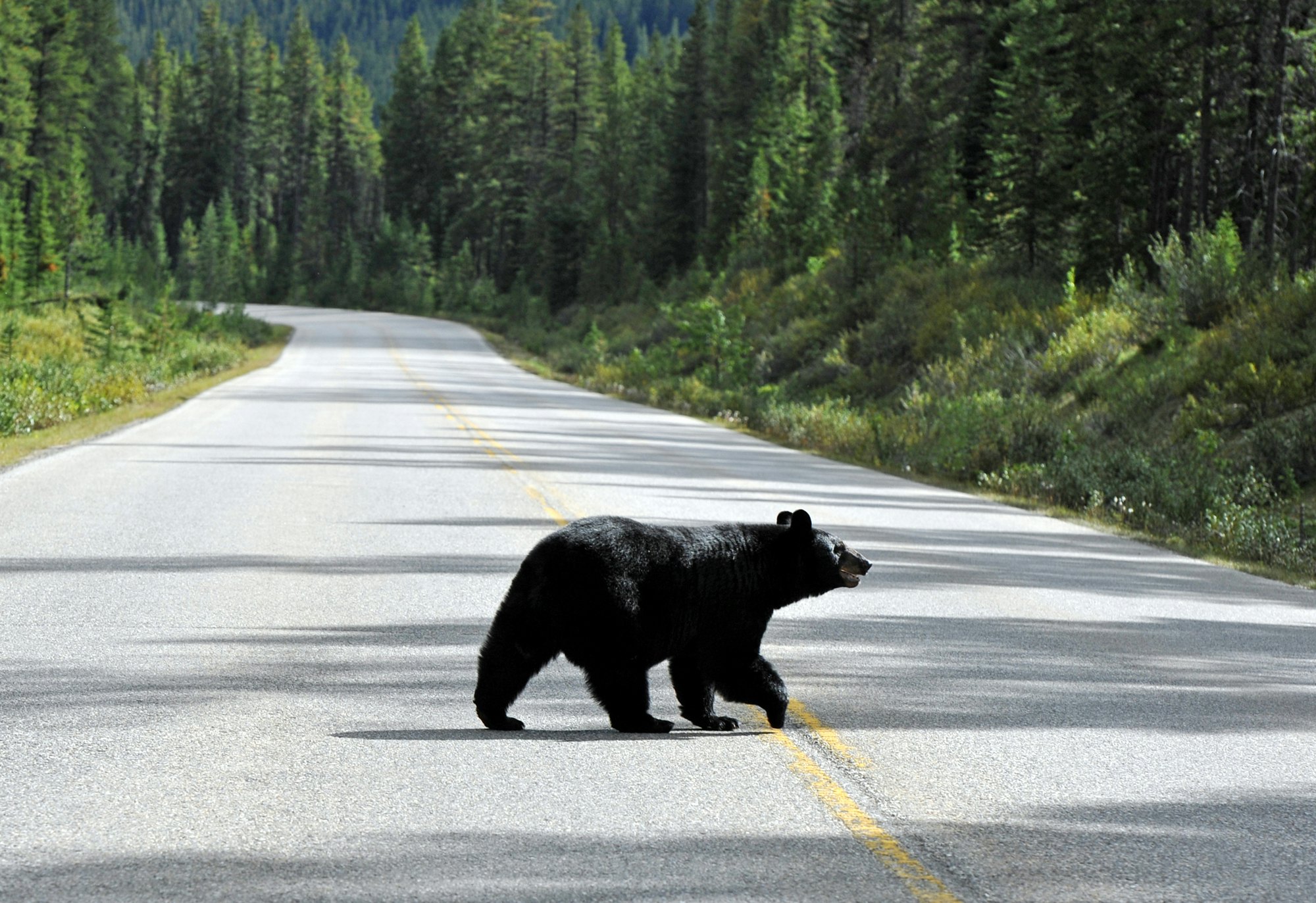
Where are the best places for wildlife?
Vermilion Lakes is a hot spot for wildlife near town, great for waterfowl, small mammals and the occasional moose. In summer it's easy (and safest) to spot grizzly bears on the slopes of Whitehorn Mountain (a wildlife corridor) from the Lake Louise gondola. Note that Larch Valley and Paradise Valley near Lake Louise have seasonal hiking restrictions from mid-July to October (hiking groups of four only) due to the density of the bear population. The Bow Valley Parkway is a quiet back-route between Banff Town and Lake Louise (the original and only road until the 1960s), where you’ll likely see bighorn sheep, black bears, elk, deer and coyotes.
Can I rent a kayak or canoe?
You can rent a kayak or canoe, though it’s more economical to bring your own if you can. If you’re renting, your cheapest bet is from the boat rental service at Lake Minnewanka, where kayaks cost $49 (US$34) for the first hour. Banff Canoe Club on the Bow River offers canoes with easy access to Vermilion Lakes for $65 (US$46) for the first hour. There are ultra expensive canoe rentals (from $145/US$102 for the first hour) at the historic boathouses on Lake Louise and Moraine Lake.






